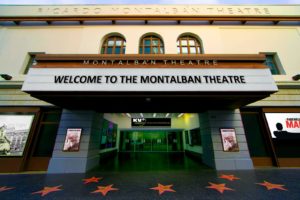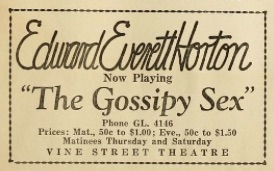Montalban Theatre Continues History of Multi-media Uses
Tag: Historic Hollywood
Just half a block from the intersection of Hollywood and Vine, the Montalban Theatre has survived alterations and changing times to remain at the forefront of entertainment, a bastion of multi-media. Whether serving as legitimate theatre, movie house, radio playhouse, or training ground, the Montalban has remained a top entertainment venue for 92 years.
 Just half a block from the intersection of Hollywood and Vine, the Montalban Theatre has survived alterations and changing times to remain at the forefront of entertainment.
Just half a block from the intersection of Hollywood and Vine, the Montalban Theatre has survived alterations and changing times to remain at the forefront of entertainment.
In 1926, Hollywood was growing ever more commercial and urban, as the booming motion picture industry lured dreamers westward. All types of entertainment flourished, whether movies, vaudeville, or the stage. Director Cecil B. DeMille announced in February of that year that he attended to build a grand theatre on Vine Street just south of Hollywood Boulevard, but his plans fell through. Frank B. Strong and John F. Wilson picked up the idea and decided to turn the filmmaking capital into a serious theatrical community by building a luxurious legitimate stage.
Strong and Wilson approached real estate man Jacob Stern, who owned property adjacent to the prime intersection of Hollywood Boulevard and Vine Street, and on which they hoped to break ground on a hotel. In September 1924, Stern had subdivided the property and created an exclusive hotel called the Hollywood Plaza just south of Hollywood Boulevard on Vine Street on part of the acreage.
Realizing the prime location made purchasing it to prohibitive, Strong and Wilson decided to take out a 99 year lease with Stern at 1615 Vine Street in order to construct the theatre proposed by DeMille, using the same plans drawn up by renowned architect Myron Hunt, designer of such iconic buildings as the Rose Bowl, the Huntington Library, and the now demolished Ambassador Hotel.
As early as February, Film Daily reported that Strong and Wilson would spend $400,000 on the construction and furnishing of the luxurious theatre. They reported in November of that year that a new type of plaster being employed in construction would absorb sound waves, eliminate echoing and interference and therefore insure a more complete auditory experience.
Scofield Engineering Construction Co. would build the facade based on Hunt’s neo-classical Italian design. Newspaper stories reported on the reinforced concrete that would be employed in constructing the theatre. Alfred G. Wilkes and his brother Thomas were hired as theatre operators in the fall 1926, managing the operations of the stage. They intended to stage important New York productions with new and rising stars of both stage and screen.
When the theatre opened on January 19, 1927, it served as Hollywood’s first legitimate stage. Theodore Dreiser’s “An American Tragedy” inaugurated the house, starring rookie film actor Lesley Fenton as the conflicted male character. The production won fine reviews for both acting and stage work. Throughout the year, such top stars as Joseph Schildkraut, Henry Kolker, Bessie Barriscale, and rising star Douglas Fairbanks Jr. appeared onstage.
 In 1928 movie/theatre comic Edward Everett Horton took over the stage as producer and actor, managed by his brother Winter D. Horton. Horton appeared in such plays as “Her Cardboard Lover,” “Gossipy Sex,” and “The Queen’s Husband.”
In 1928 movie/theatre comic Edward Everett Horton took over the stage as producer and actor, managed by his brother Winter D. Horton. Horton appeared in such plays as “Her Cardboard Lover,” “Gossipy Sex,” and “The Queen’s Husband.”
When the Depression hit, The Wilkes Brothers rented out the theatre to special purposes, including screenings of Photophone, until they sold it in 1931 to aviator Howard Hughes and motion picture executive Harold B. Franklin to serve as a movie house in their new movie distribution chain. It opened March 12, 1931 as the Mirror Theatre, showing films twice daily, most from major studios.
By 1935, movie screenings were over and the Vine Street Theatre at 1615 Vine St. returned to presenting legitimate theatre, this time under the name Hollywood Theatre Guild. When they failed to create huge interest in seeing classic films, they sold the theatre in 1936 to Columbia Broadcasting System. CBS remodeled the theatre with the help of the Parkinson and Parkinson Co., opening it as the CBS Radio Playhouse on Janary 2, 1937. The theatre served as the soundstage for the recording of Lux Radio Theatre plays under the direction of legendary film producer Cecil B. DeMille. Such celebrities as Cary Grant, William Powell, Myrna Loy, Barbara Stanwyck, Marlene Dietrich, Orson Welles, Errol Flynn, and Jean Harlow would star in radio plays recorded at the theatre.
] The theatre served as the soundstage for the recording of Lux Radio Theatre plays under the direction of legendary film producer Cecil B. DeMille.
The theatre served as the soundstage for the recording of Lux Radio Theatre plays under the direction of legendary film producer Cecil B. DeMille.
As television became popular in the late 1940s-early 1950s, radio shows began losing much of their audience. CBS sold the theatre to A & P grocery store heir Huntington Hartford on July 9, 1953. He would convert it back to legitimate theatre and acting workshop space and streamline the space. Hartford renamed the theatre after himself, erected a new marquee, revamped toilets, lounge, stage lights, ceiling, auditorium, and cocktail areas, all to make it a high-class destination for serious productions.
In 1964, Hartford sold out to theatre impresario James Doolittle, owner and operator of the Greek Theatre. He christened the theatre the Doolittle Theatre, which remained active as a legitimate stage under 1999, when it was acquired by Nosotros and the Ricardo Montalban Foundation and renamed the Montalban Theatre. It was the first major theatre in the United States named after a leading Latino performing artist.
Over time, the owners have been renovating the theatre and returning it to its original glory, where they host special concerts, screenings, interviews, and plays. The theatre also presents rooftop movies throughout the year, continuing the long tradition of adaptive reuse and employing multi-media to reach new audiences. The Montalban Theatre demonstrates that elegant, 92-year-old buildings can fill customers’ needs in lush surroundings with creativity and imagination.
Mary Mallory is the author of Hollywoodland and three other books. She also writes for the blog the LA Daily Mirror and serves on Hollywood Heritage’s Board of Directors.